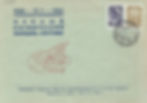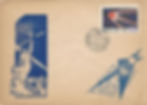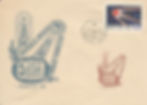
First around Earth
The first satellite was a very primitive body with almost no instrumentation. Khrushchev ordered to launch a more complex machine by November 1957 – towards the 40th anniversary of October Revolution (many things in USSR were done towards communist anniversaries like Lenin birthdays or October Revolution and Victory Day sometimes without proper thinking...). The spacecraft was not ready and in order to fulfil the demand of the Communist Party leader, Korolev rapidly designed quite simple satellite that should not separate from the upper stage of the rocket, using its telemetry equipment, putting Laika dog inside. Thus literally, the more "advanced" type of spacecraft - Sputnik 2, was launched plus hosting a living creature, that actually was not as important as it turned to be in future.





2000 orbits of 2nd satellite red official cancellation on the Moscow City Collector Society cover

a "well-formed" serviced cover with official cancellation for 2000 orbits of 2nd satellite

1st anniversary





The third satellite was a fully equipped spacecraft launched from the second try on May 15, 1958 (the first launch turned to be a disaster when launch vehicle exploded after 2 minute flight). Sputnik 3 was fully controllable from Earth, weighted “enormous” 1327 kg, held scientific equipment and transmitted a huge amount of much needed data during the whole flight duration until de-orbiting on April 6, 1960. In the astrophilately this event was widely celebrated on official and club covers. The image of Sputnik 3 appeared along with the Sputnik and even became a trademark of the
Mezhkniga covers. Notable remark - Sputnik 3 launch was dedicated to XXI congress of Communist party (January 1959) and that fact was reflected on the covers as well.



1000 orbits of 3rd satellite special cancellation on philex cover


2000 orbits

3000 orbits of 3rd satellite special cancellation on philex cover

3000 orbits of 3rd satellite official postmark

3000 orbits of 3rd satellite official cancellation on the Moscow City Collector Society cover


4000 orbits of the 3rd satellite club black cancellation

5000 orbits of 3rd satellite cancellation on official Mezhkniga cover

6000 orbits

8000 orbits

First Day Mezhkniga cancellation in the form of 3rd satellite on official cover.

10 000 orbits of 3rd satellite official cancellation

10 000 orbits of 3rd satellite official postmark

10 000 orbits of 3rd satellite official cancellation on the cover with dedication to XXI congress of Communist party

10 000 orbits of 3rd satellite official cancellation

a "well-formed" serviced cover with official cancellation for XXI congress of Communist party. Note the image of 3 first satellites over the Kremlin

2nd anniversary of First satellite launch

small stamp - unofficial


10000 orbits

serviced cover with club cancellation for 10 000 orbits of 3rd satellite


3rd satellite 1st anniversary club cancellation and cover

serviced cover with club cancellation for 10 000 orbits of 3rd satellite


3rd satellite 1st anniversary club cancellation and cover

10 000 orbits of 3rd satellite club cancellation and cover

serviced cover









last day on orbit of the 3rd satellite club cancellation

last iteration

2nd anniversary Baku

4th anniversary Kiev Young Collector's Club

4th anniversary Krasnoyarsk

4th anniversary Baku

4th anniversary Taganrog


5th anniversary Riga

Riga - serviced cover

5th anniversary Magadan

5th anniversary Magadan

5th anniversary Baku

5th anniversary Simferopol

5th anniversary Arkhangelsk

1000 revolutions

Minsk

Kniga cover


Kiev club cover
Heavy Satellite 01 (also known as Sputnik 7 or Giant satellite) was actually an unsuccessful launch of Venera-1 spacecraft to Venus. The probe should have reached Venus and deliver a container with a USSR medal to the surface. Due to acceleration failure Venera-1 remained on the Earth orbit rapidly de-orbiting and disintegrated over Eastern Siberia. Soviet media (as usual) reported about successful launch of “first heavy” Earth satellite and well planned flight; this was reflected on the covers as well. Interestingly, the container with the medal was found by a boy in 1963 and returned to the Korolev OKB-1.

5th anniversary of 3rd satellite launch Minsk club cover

5th anniversary of 3rd satellite launch Liepaja club cover


Giant satellite


Heavy satellite

1st anniversary Baku

2nd anniversary, Šilutė

2nd anniversary Vinnitsa

2nd anniversary Baku

2nd anniversary Kharkov

50th anniversary

In 1962 a major space event has been celebrated – 5 years since First satellite was launched that actually marked the 5th anniversary of “Space Era”. In astrophilately this milestone was treated accordingly. Official stamp, covers and cancellations were issued. Sputnik anniversary official special cancellation was applied in 19 cities. I do not have all the places - this was not my goal, just some. Many clubs issued special cachets and cancellations, some in several variations of colors and even types of cachets. Some issued only cachets and used official postmark, others used their own cancellation on the official covers. In general most of the covers can be seen quite often and cost $5 and less.

official black postmark on the official cover and stamp

serviced cover

official red Moscow International Post Office cancellation on the official "art" cover from GlavRosKniga publishing house

official "art" cover from GlavRosKniga with Moscow International Post Office First Day cancellation

official cancellation on official cover

nicely designed cover with 1957 First satellite stamps including overprinted Tsiolkovsky




club cover with official cancellation

Moscow International Post Office red postmark on Moscow City Collector society club cover

another example of Moscow club cover note the different text and color of cachet

club cover

purple club cancellation on blue club cover

black club cancellation on red club cover

club cover

club cover

club cover serviced in 1967 addressed to the head of USSR Philatelic Society from Kharkov affiliate

club cover

red cancellation with brown cachet

blue cancellation with blue cachet

club cover

white paper with red cachet although the cachet show the first cosmonauts to fly before Oct 4, 1962, the event is dedicated to the 5th anniversary of the First satellite launch, as written on the cover

blue paper with black cachet

club cover

Young Collectors Club cover and cancellation + official special postmark

club cover

club cover

club cover

vignette full sheet

club cancellation on official cover





club cover

club cover

club cover

club cover

club cover




Club cover
















Penza

Penza

Šilutė
One HUGE portion of Soviet “club” covers has been devoted to Kosmos satellites, beginning with Kosmos-1 (also known as Sputnik 11). “Kosmos series” was a product of secrecy around Soviet space program that had a clear military direction. Basically any launch could be designated as Kosmos + number and there was no need to elaborate on the new type of spacecraft and its application, as well as there were no difference between success and failure in terms of propaganda.
Around 2500 Kosmos launches were done from Baikonur, Plesetsk and Kapustin Yar. As a rule of thumb, Kosmos designation was given to the Earth orbit satellites, including lunar spaceships and interplanetary probes that did not leave to their respective targets. Some Kosmos launches gained fame, like Kosmos-110 with Ugolek and Veterok “space dogs”, Kosmos-672 ASTP testbed, Kosmos-1445 Buran testbed, Kosmos-954 nuclear powered satellite that crashed in Canada in 1978 and some others. But all began in 1962.
There are really a lot of covers marking Kosmos satellites in the first several years especially until 1966 before mass “club” cover movement almost ceased to exist, leaving lonely private initiatives that continued through 70s. I never paid much attention to the Kosmos events, but as they are very numerous I also have some in my collection. Possibly will add more, but not at the first priority.

Krasnodar

Stanislav

Moscow

Moscow Mezhkniga cover

Stanislav

Minsk

Minsk

Bayan Aul

Magnitogorsk

Magnitogorsk

Minsk

Baku

Stanislav

Minsk

Magnitogorsk

Magnitogorsk

Magnitogorsk

Bayan-Aul

Bayan-Aul


Minsk

Baku

Stanislav

Stanislav

Arkhangelsk

Lvov

Lvov

Baku
Tartu “club” covers.
Tartu Collectors Club is by all means the most prolific and well-known to the astrophilately society. It appeared in 1962 under the leadership of Juhan Noormagi and from 1963 began its production of topical space cachets and hand stamped marks commemorating every space-related event of the former USSR starting from Kosmos-20 launch and until 1965 when its coverage became loose and more selective. These activities continued through 1978.
Tartu “club” covers introduced a single cachet model for numerous events with the same “core logic” – like Luna, Zond, Venera, Mars probes and Soyuz launches. In this model the main cachet remained the same allowing hand stamped changes in the name, number and other details. In total 40 different cover types were designed with at least 306 various hand stamped cachets made in different colors. The numbers of each type of event cover production went through 250 pieces in most cases.
Note that sometimes “incomplete” Tartu covers can be found – mostly only with club cachets lacking official postmarks – these were probably taken from production leftover. Interestingly although Tartu Collectors Club was a former USSR territory, the covers are mostly available on from the Western sources and quite rare with Russian dealers.
Info taken from Jim Reichman article in ORBIT #93

Riga, 1963

Kaluga, 1963

Kaluga, 1963







Tartu

Stanislav

Tartu

Ivano-Frankovsk

Tartu

Tartu

Tartu

Tartu

Baku

Baku

Baku

Tartu

Ivano-Frankovsk

Arkhangelsk

Baikonur forged cancellation

Arkhangelsk

Tartu

Baku

Tartu

Liepaja

Tartu

Tartu

Tartu

Tartu

Arkhangelsk

Tartu

Tomsk

Shilute

Shilute

Odessa
Another philatelic excitement was devoted to Polyot and Elektron series of satellites.
Maneuvering spacecraft Polyot -1 and Poyout-2 were launched by Polyot rocket launch vehicle (11A59) – a lightweight version of R-7 developed by Vladimir Chelomey. The main idea of the project was to develop and test the measures of confronting American spy satellites. Actually Polyot satallites served as prototypes for the first operational interceptors of satellites launched in 1968-1970.
On the other hand four Elektron satellites served pure scientific needs – measuring of Earth radiation. They had a very high elliptical orbit – up to 60,000 km for the Elektron-2 and 4. The experiments were devoted to the Year of Quite Sun.

Arkhangelsk

Perm

Ivano-Frankovsk

Tartu

Baku

Baikonur forged cancellation

Tartu

5th anniversary Baku

Arkhangelsk

Arkhangelsk

Kaliningrad

Minsk



Vinnitsa

Perm

Perm

Tartu

Ivano-Frankovsk

Ivano-Frankovsk

Vinnitsa 1964

Tartu

Arkhangelsk

scientific satellite for exploring space radiation Perm
